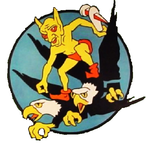This article has multiple issues. Please help improve it or discuss these issues on the talk page. (Learn how and when to remove these messages)
|
The 339th Flight Test Squadron is a United States Air Force unit based at Robins Air Force Base, Georgia. It is part of the Warner Robins Air Logistics Center, with a mission to certify aircraft as worthy to return to service. The squadron is responsible for conducting flight tests on the Lockheed C-130 Hercules, the Lockheed C-5 Galaxy and McDonnell Douglas F-15 Eagle after program depot maintenance is completed.
339th Flight Test Squadron
 | |
|---|---|
 Eddie Minter, C-130 functional test work lead, meets with MSgt. Tony Valente, flight engineer to look over work records before a testflight of an MC-130E | |
| Active | 1942–1946; 1946–1958; 1975–1983; 1988–present |
| Country | |
| Branch | |
| Role | Flight Testing |
| Part of | Air Force Materiel Command |
| Garrison/HQ | Robins Air Force Base, Georgia |
| Motto(s) | Respice Finem Latin Examine the End (1988–1992)[1] |
| Engagements |
|
| Decorations |
|
| Insignia | |
| 339th Flight Test Squadron emblem (approved 19 October 1955, reinstated 20 October 1992)[1][2] |  |
| 2875th Test Squadron emblem (approved 30 November 1988)[1] |  |
| 339th Fighter Squadron emblem (approved 2 December 1942)[1] |  |

Along with their flight test responsibilities, the squadron also picks up and delivers aircraft, including battle-damaged aircraft, to locations where they are needed or can be repaired.
During World War II, the squadron was given, and successfully carried out, the assignment to shoot down the plane carrying Imperial Japanese Navy Admiral Isoroku Yamamoto in Operation Vengeance.
History
editWorld War II
editCombat in South and Southwest Pacific, c. 22 October 1942 – 8 August 1945. As the 339th Fighter Squadron, notably carried out Operation Vengeance on 18 April 1943, resulting in the death of Japanese admiral Isoroku Yamamoto, who had planned the attack on Pearl Harbor. Multiple pilots in the squadron earned the Navy Cross for their roles in the mission.
Air defense of Japan and Korean War
editThe squadron was reactivated on 20 February 1947, when it took over the personnel and aircraft from the 6th Night Fighter Squadron, which was simultaneously inactivated. Air defense in Japan, 1946–1958. Combat in Korea, 27 June – 5 July 1950.
Tactical Air Command
editThe squadron was inactivated in August 1983 and its personnel and aircraft were transferred to the 69th Tactical Fighter Squadron, which was simultaneously activated.
Flight test operations
editTested possible modifications for various weapons systems, 1988–.
Lineage
edit- 339th Tactical Fighter Squadron
- Constituted as the 339th Fighter Squadron on 29 September 1942
- Activated on 3 October 1942
- Redesignated 339th Fighter Squadron (Twin Engine) on 23 February 1943
- Redesignated 339th Fighter Squadron, Two Engine on 20 August 1943
- Inactivated on 1 January 1946
- Redesignated 339th Fighter Squadron, Single Engine on 13 July 1946
- Activated on 25 August 1946
- Redesignated 339th Fighter Squadron (All Weather) on 20 February 1947
- Redesignated 339th Fighter Squadron, All Weather on 10 August 1948
- Redesignated 339th Fighter-All Weather Squadron on 20 January 1950
- Redesignated 339th Fighter-Interceptor Squadron on 25 April 1951
- Inactivated on 15 January 1958
- Redesignated 339th Tactical Fighter Squadron on 19 December 1975
- Activated on 30 December 1975
- Inactivated on 1 July 1983
- Consolidated with the 2875th Test Squadron as the 339th Test Squadron on 1 October 1992[2]
- 339th Flight Test Squadron
- Designated as the 2875th Test Squadron and activated on 15 January 1988
- Consolidated with the 339th Tactical Fighter Squadron as the 339th Test Squadron on 1 October 1992
- Redesignated 339th Flight Test Squadron on 15 March 1994[2]
Assignments
edit
|
|
Stations
edit
|
|
Aircraft operated
edit- Bell P-400, 1942
- Bell P-39 Airacobra, 1942–1943
- Lockheed P-38 Lightning, 1942–1945
- Northrop P-61 Black Widow (later F-61, 1947–1950
- North American F-82 Twin Mustang, 1949–1951
- Lockheed F-94 Starfire, 1951–1955
- Lockheed F-80 Shooting Star, 1953–1954
- North American F-86 Sabre, 1955–1957
- McDonnell F-4 Phantom II, 1976–1983[2]
References
edit- Notes
- ^ Aircraft are North American F-82E Twin Mustangs. Serial 46-353 is in the center. Taken in 1950.
- Citations
Bibliography
editThis article incorporates public domain material from the Air Force Historical Research Agency
- Maurer, Maurer, ed. (1983) [1961]. Air Force Combat Units of World War II (PDF) (reprint ed.). Washington, DC: Office of Air Force History. ISBN 0-912799-02-1. LCCN 61060979. Retrieved 17 December 2016.
- Maurer, Maurer, ed. (1982) [1969]. Combat Squadrons of the Air Force, World War II (PDF) (reprint ed.). Washington, DC: Office of Air Force History. ISBN 0-405-12194-6. LCCN 70605402. OCLC 72556. Retrieved 17 December 2016.
- Pape, Garry R.; Campbell, John M.; Campbell, Donna (1991). Northrop P-61 Black Widow: The Complete History and Combat Record. Minneapolis, MN: Motorbooks International. ISBN 978-0-879385-09-5.
- Ravenstein, Charles A. (1984). Air Force Combat Wings, Lineage & Honors Histories 1947–1977. Washington, DC: Office of Air Force History. ISBN 0-912799-12-9. Retrieved 17 December 2016.